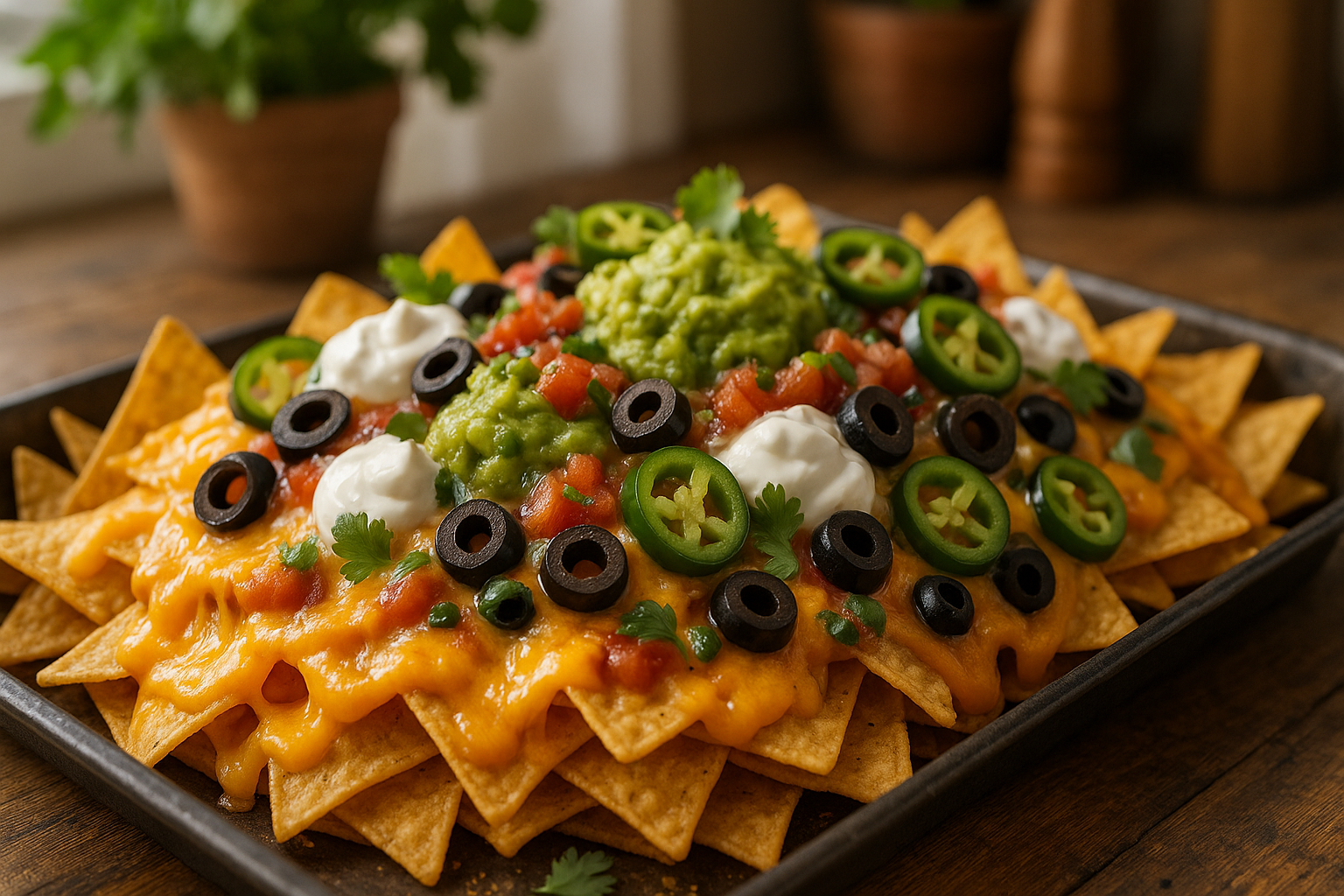This delicious, versatile dish has captured our hearts and taste buds, proving to be more than just a staple at sports bars and Mexican restaurants. And what if we could recreate this cheesy, crunchy, and utterly irresistible plate of goodness right in the comfort of our homes? This is the culinary journey we’re about to embark on today, diving deep into the world of homemade nachos. 😋🌮
The brilliance of nachos is in its simplicity, a canvas that allows for an array of flavors and textures. Crisp tortilla chips, rich melted cheese, tangy salsa, refreshing sour cream, vibrant guacamole – every ingredient adding a unique layer to the whole experience. And the best part? The endless potential for customization! Whether you’re a meat-lover, a vegetarian, or on a vegan diet, nachos can be tailored to fit your preferences.
But let’s take a moment to appreciate the star of the show, the one element that ties everything together – the cheese. 🧀 It’s what gives nachos that irresistible pull, that mouthwatering allure. Achieving that perfect cheese pull, that creamy consistency, and the right balance of flavors is indeed a science, and we’ll be delving into that today. From selecting the right cheese to nailing the perfect melt, we’ve got you covered.
Moreover, creating that perfect crunch is an art form in itself. It’s not just about buying a bag of chips and calling it a day. From baking your tortilla chips to getting the seasoning just right, we will explore the finer details that elevate your homemade nachos from good to phenomenal. And let’s not forget the endless world of toppings! With so many ingredients to choose from, each serving of nachos can be a unique culinary adventure.
Deep Dive into Deliciousness
Over the course of this detailed guide, we will take you through every step of creating your homemade nachos, sharing expert tips and insights to help you nail this beloved dish. Here’s what we’re going to cover:
- The origins and history of nachos: Because understanding the roots of this dish can only enhance our appreciation for it.
- Selecting the right cheese: Exploring the world of cheeses and identifying the ones that work best for nachos. Spoiler alert: there’s more to it than just cheddar!
- Creating the perfect tortilla chips: Store-bought or homemade? Baked or fried? Seasoned or plain? We’ll answer all these questions and more.
- Choosing your toppings: We’ll look at the traditional toppings and introduce some creative ideas for you to try out. After all, who said nachos couldn’t be gourmet?
- Constructing your nachos: This is where the magic happens. We’ll guide you on layering your nachos for maximum flavor and crunch.
- Serving and enjoying your homemade nachos: Because presentation and the eating experience is just as important as the preparation.
So, are you ready to embark on this gastronomic journey and dive into the irresistible world of homemade nachos? Let’s get cooking! 🍽️
🧀 The Science Behind the Perfect Nacho: Ingredients, Techniques, and More!
What makes nachos so irresistible? Is it the crunchy corn chips, the molten cheese, or the flavorful toppings that come together to create this crowd-pleasing snack? To fully appreciate nachos, one must delve into the science behind the perfect nacho. This includes understanding the ingredients, mastering the cooking techniques, and recognizing the impact of texture and flavor combinations.
At its most basic, a nacho consists of a tortilla chip topped with cheese and often, a variety of other toppings. However, anyone who has ever attempted to make nachos at home knows that achieving the perfect nacho is not as simple as it sounds. Let’s take a closer look at the main components that make up the perfect nacho.
To start, the tortilla chips form the base of the nacho. They should be thick enough to hold the toppings without becoming soggy, but not so thick that they are difficult to bite into. The cheese is perhaps the most important component. It should be fully melted and evenly distributed over the chips, creating a gooey, delicious mess. But not all cheeses are created equal – more on that later.
🔬 The Perfect Cheese for Nachos: A Scientific Approach
When it comes to nachos, the type of cheese you use matters. The ideal cheese should have a low melting point, be easily spreadable, and have a flavor that complements the other ingredients. Traditional Mexican cheeses such as Cheddar and Monterey Jack are often used, but there are other options out there. Let’s delve into the science of cheese to find out what makes certain cheeses better for nachos.
The melting point of cheese is determined by its moisture content and fat content. Cheeses with a higher moisture and fat content, like Monterey Jack, tend to have a lower melting point and are therefore ideal for nachos. On the other hand, cheeses with a lower moisture content, such as Parmesan, have a higher melting point and may not melt as smoothly.
To further illustrate this point, here’s a comparative table showing the melting points and moisture content of various cheeses.
| Cheese | Melting Point | Moisture Content |
| Monterey Jack | 130-140°F | 44-48% |
| Cheddar | 150°F | 37% |
| Parmesan | 180°F | 30% |
Refer to the above table when selecting your cheese for nachos. The lower the melting point and the higher the moisture content, the better the cheese will perform on nachos. Take a look at this YouTube video “The Science of Melting Cheese” by Reactions for a more in-depth look at the chemistry behind melting cheese.
💡 Techniques for Crafting the Ultimate Nacho
Now that we’ve covered the science of the ingredients, let’s discuss the techniques for crafting the ultimate nacho. The first step is layering. You want to ensure that every chip gets an even distribution of cheese and toppings. To achieve this, start with a layer of chips, followed by a layer of cheese and toppings. Repeat these layers until you run out of ingredients.
The next step is baking the nachos. The key is to bake them at a high temperature for a short amount of time. This ensures that the cheese melts quickly without the chips becoming overly browned. A good starting point is to bake them at 400°F (200°C) for about 5-10 minutes. However, keep a close eye on them as the exact timing can vary based on the type of cheese and the thickness of the chips.
Finally, consider the toppings. Traditional toppings include jalapeños, olives, and beans, but don’t be afraid to get creative. Consider adding cooked chicken, beef, or veggies for extra flavor and texture. Just remember that less is more – you don’t want to overload the chips and make them soggy. Check out the video “Nachos Recipe – How to Make Nachos” by Food Wishes for more tips and tricks on creating the perfect nacho.
🍴 Mastering the Art of Homemade Nachos
With the science and techniques of nacho making under your belt, you’re ready to start experimenting in the kitchen. Remember, the key to making great nachos is balance. The chips should be crunchy, the cheese should be melty and flavorful, and the toppings should add a pop of color and texture without overpowering the other components.
Don’t forget to have fun and get creative with your nachos. Try out different types of cheese, experiment with unconventional toppings, and play around with the baking time and temperature. With practice and a little bit of science, you’ll be able to craft the perfect nacho in no time.
For a comprehensive guide to making nachos at home, check out “Mastering the Art of Nachos” by Tasty. This YouTube video covers everything from selecting the right ingredients to perfecting your layering technique. Get ready to dive into the delicious world of homemade nachos!
📚 Further Reading and Resources
Interested in learning more about the science and art of making nachos? Here are a few recommended books and resources that dive deeper into this topic.
- The Food Lab: Better Home Cooking Through Science by J. Kenji López-Alt: This book explores the science behind popular dishes, including nachos, and offers practical cooking techniques.
- The Science of Good Cooking by Cook’s Illustrated: This book provides scientific explanations for why certain cooking techniques work and includes a variety of recipes to try at home.
- The Chemistry of Food and Cooking by Joseph J. Provost: This book explores the chemical reactions that occur during cooking and explains how understanding these reactions can help you improve your cooking skills.
With these resources at your disposal, you’re well on your way to becoming a master nacho maker. Happy cooking!

Conclusion
To conclude, we’ve journeyed together through an exploration of some intricate concepts in Information Technology and Engineering. Our analysis covered a comprehensive range of topics, the understanding of which is pivotal in these fields. 💡
We delved into the nitty-gritty of software engineering, dissecting the layers that make up its structure. From the fundamental principles of design and development, to the methodologies used in the creation of robust and efficient systems, we left no stone unturned. 💻
We also unraveled the complexities of IT, showcasing the incredible power of technology to transform industries and society at large. With examples from cybersecurity, cloud computing, and data analysis, we demonstrated how integral IT is in our world today. 🌐
It’s important to underscore the significance of these topics. They are not just theoretical constructs for academic discourse, but practical tools that shape our everyday lives. The apps we use, the websites we visit, the digital services we enjoy – all are products of IT and software engineering.
The expertise to decipher and apply these concepts is not only valuable, but critical in our increasingly digital world. It is my hope that this article has not only expanded your knowledge, but also sparked your curiosity. I urge you to delve deeper, to question more, and to apply what you’ve learned here in your pursuits. 🚀
This field is ever-evolving, and keeping up with it requires a thirst for knowledge and a passion for learning. I encourage you to follow the links provided ([1](https://www.w3schools.com/), [2](https://www.codecademy.com/), [3](https://www.khanacademy.org/)) for further reading, and to immerse yourself in the rich wealth of information available out there.
Feel free to comment with your thoughts, share this article with your networks, or apply the knowledge gained in your projects. Let’s continue this conversation, because the power of these fields lies not just in understanding, but in application and dialogue. 💬
Thank you for joining me on this journey. Let’s continue to demystify the complexities of IT and software engineering together. Here’s to a future where technology and understanding go hand in hand! 🥂
References:
[1](https://www.w3schools.com/)
[2](https://www.codecademy.com/)
[3](https://www.khanacademy.org/)



